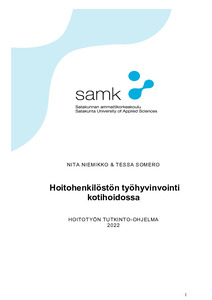Hoitohenkilöstön työhyvinvointi kotihoidossa
Niemikko, Nita; Somero, Tessa (2022)
Niemikko, Nita
Somero, Tessa
2022
All rights reserved. This publication is copyrighted. You may download, display and print it for Your own personal use. Commercial use is prohibited.
Julkaisun pysyvä osoite on
https://urn.fi/URN:NBN:fi:amk-2022121328383
https://urn.fi/URN:NBN:fi:amk-2022121328383
Tiivistelmä
Opinnäytetyön tarkoitus oli selvittää, millaiseksi hoitohenkilöstö kokee työhyvinvointinsa kotihoidossa. Tavoite oli tuottaa tietoa hoitohenkilöstön työhyvinvoinnista kotihoidossa.
Opinnäytetyö toteutettiin kvantitatiivisena eli määrällisenä tutkimuksena. Tutkimusaineisto kerättiin sähköisen kyselylomakkeen avulla. Kyselyyn vastasi Rauman kotihoidon työntekijät, yhteensä vastauksia tuli 54, joista opinnäytetyöhön hyväksyttiin 48 (n=48). Vastausprosentti 28,24.
Opinnäytetyön kyselyn vastaukset antoivat selkeän kuvan työntekijöiden työhyvinvoinnista. Tuloksista selvisi kyselyyn vastanneiden työntekijöiden työhyvinvoinnin olevan ihan hyvällä tasolla Rauman kotihoidossa. Monet kokevat työssään kiirettä, stressiä ja kuormittavuutta, jotka teoriatiedon mukaan vaikuttavat työhyvinvointiin. Parhaimmillaan lähes kaikki työntekijät ovat kokeneet työhyvinvointinsa hyväksi. Kuitenkin nyt tämänhetkinen työhyvinvointi jakautuu hyvän ja kohtalaisen välille.
Jatkotutkimuksena voisi tehdä kyselyn, joka toisi esille kotihoidon työntekijöiden mielestä työhyvinvointiin vaikuttavia tekijöitä. Tämä opinnäytetyön työhyvinvointikyselyn jatkeeksi voisi ajatella myös kyselyä, minkä avulla saisi tieto siitä mihin tämän kyselyn hoitohenkilöstön vastaukset perustuvat. Kyselyllä haettaisiin konkreettisia syitä kyseisen kyselyn vastauksiin. Tämän opinnäytetyön työhyvinvointikysely olisi myös mielenkiintoista toteuttaa myöhemmin uudelleen samalle kohderyhmälle. The purpose of the thesis was to find out how the nursing staff perceives their well-being at work in home care. The goal was to produce information on the occupational well-being of nursing staff in home care.
The thesis was carried out as a quantitative research. The research material was collected using an electronic questionnaire. Rauma's home care workers responded to the survey, a total of 54 responses were received, of which 48 (n=48) were accepted for the thesis. Response rate 28.24.
The answers to the thesis survey gave a clear picture of the employees' well-being at work. The results revealed that the occupational well-being of the employees who responded to the survey was at a very good level in Rauma's home care. Many people experience rush, stress and workload at work, which, according to theory, affect well-being at work. At best, almost all employees have experienced their well-being at work to be good. However, the current well-being at work is divided between good and moderate.
As a follow-up study, a survey could be conducted that would bring out the factors affecting the well-being of the home care workers. As a follow-up to the occupational well-being survey of this thesis, you could also think of a survey, which would help you get information on what the nursing staff's answers to this survey are based on. The survey would seek concrete reasons for the answers to that survey. The work well-being survey of this thesis would also be interesting to implement again later for the same target group.
Opinnäytetyö toteutettiin kvantitatiivisena eli määrällisenä tutkimuksena. Tutkimusaineisto kerättiin sähköisen kyselylomakkeen avulla. Kyselyyn vastasi Rauman kotihoidon työntekijät, yhteensä vastauksia tuli 54, joista opinnäytetyöhön hyväksyttiin 48 (n=48). Vastausprosentti 28,24.
Opinnäytetyön kyselyn vastaukset antoivat selkeän kuvan työntekijöiden työhyvinvoinnista. Tuloksista selvisi kyselyyn vastanneiden työntekijöiden työhyvinvoinnin olevan ihan hyvällä tasolla Rauman kotihoidossa. Monet kokevat työssään kiirettä, stressiä ja kuormittavuutta, jotka teoriatiedon mukaan vaikuttavat työhyvinvointiin. Parhaimmillaan lähes kaikki työntekijät ovat kokeneet työhyvinvointinsa hyväksi. Kuitenkin nyt tämänhetkinen työhyvinvointi jakautuu hyvän ja kohtalaisen välille.
Jatkotutkimuksena voisi tehdä kyselyn, joka toisi esille kotihoidon työntekijöiden mielestä työhyvinvointiin vaikuttavia tekijöitä. Tämä opinnäytetyön työhyvinvointikyselyn jatkeeksi voisi ajatella myös kyselyä, minkä avulla saisi tieto siitä mihin tämän kyselyn hoitohenkilöstön vastaukset perustuvat. Kyselyllä haettaisiin konkreettisia syitä kyseisen kyselyn vastauksiin. Tämän opinnäytetyön työhyvinvointikysely olisi myös mielenkiintoista toteuttaa myöhemmin uudelleen samalle kohderyhmälle.
The thesis was carried out as a quantitative research. The research material was collected using an electronic questionnaire. Rauma's home care workers responded to the survey, a total of 54 responses were received, of which 48 (n=48) were accepted for the thesis. Response rate 28.24.
The answers to the thesis survey gave a clear picture of the employees' well-being at work. The results revealed that the occupational well-being of the employees who responded to the survey was at a very good level in Rauma's home care. Many people experience rush, stress and workload at work, which, according to theory, affect well-being at work. At best, almost all employees have experienced their well-being at work to be good. However, the current well-being at work is divided between good and moderate.
As a follow-up study, a survey could be conducted that would bring out the factors affecting the well-being of the home care workers. As a follow-up to the occupational well-being survey of this thesis, you could also think of a survey, which would help you get information on what the nursing staff's answers to this survey are based on. The survey would seek concrete reasons for the answers to that survey. The work well-being survey of this thesis would also be interesting to implement again later for the same target group.
